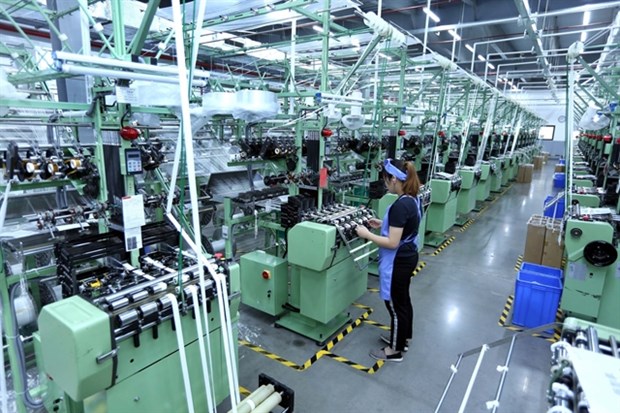Complying with origin rules critical for garment exports
To take advantage of free trade agreements and expand exports, meeting rules of origin is crucial for the garment and textile sector, industry insiders have said.
 A clothing production line of the Best Pacific Vietnam Co in the northern province of Hai Duong. (Photo: VNA)
A clothing production line of the Best Pacific Vietnam Co in the northern province of Hai Duong. (Photo: VNA)Hanoi (VNS/VNA) – To take advantage of free trade agreements and expand exports, meeting rules of origin is crucial for the garment and textile sector, industry insiders have said.
Lower-than-expected export revenue last year showed the industry was facing problems in participating more deeply in the global value chain and expanding exports to niche markets.
Le Tien Truong, General Director of the Vietnam National Textile and Garment Group (Vinatex), said 2019 was a difficult year for the industry with export revenue of 39 billion USD, 1 billion USD lower than its target.
Despite many expectations for the industry due to the Comprehensive and Progressive Trans-Pacific Partnership (CPTPP) and the EU-Vietnam Free Trade Agreement (EVFTA), Truong said it was critical for the sector to make moves to comply with origin rules to enjoy the preferential tariffs in the trade deals.
Truong said Vietnam needed to invest in fabric production to meet origin requirements when exporting to CPTPP and EVFTA countries.
This would not be easy because Vietnam must compete in terms of designs, quality, prices and delivery time with other major fabric producers like China and India, Truong said.
He said investing in fabric production needed careful consideration in terms of production scale because Vietnam’s garment industry uses less than 1 billion metres of woven and knitted fabric every year, or 18 percent of global exports.
If fabric production targeted only Vietnam, production scale would be too small while investing in large-scale production and competition with China and India must be taken into account, Truong said.
He said that Vietnamese garment firms should work with global giants to establish value chains and invest in production to meet their demands.
According to Nguyen Xuan Duong, Chairman of the Hung Yen Garment Corporation, at this time in previous years, his company had orders and contracts up until the end of the second quarter.
However, this year is different, Dương said, adding that many partners only sign short-term contracts. He said they seem to be more cautious and are watching for developments of the US – China trade war.
A report from the Ministry of Industry said many garment firms had only 80 percent of the order volume for 2020 as they did the same time last year.
Vu Duc Giang, President of the Vietnam Garment and Apparel Association, said Vietnam’s garment and textile sector must speed up reforms with innovations in designs, management, fabric production and building brands.
Giang said that this year, the sector targeted export revenue of 42 billion USD, which would require firms to invest in raw material production to meet rules of origin in trade deals.
The association’s statistics showed the garment and textile industry ran a trade surplus of 16.62 billion USD in 2019, up 2.25 billion USD compared to the previous year.
The Viet Tien Garment Joint Stock Corporation (VGG) has signed up with Luenthai and Newtech to establish the Viet Thai Tech fabric factory, which is expected to supply fabric for the garment and textile industry.
Giang said this project aims at proactively sourcing raw materials, shortening production and delivery time, as well as meeting strict quality requirements from customers in the garment industry.
The project has a total investment of 20 million USD, of which the first phase of the project is 12 million USD and the second is 8 million USD. It’s expected to be inaugurated and go into operation on June 30 this year.
Giang, who is also Chairman of VGG, said the factory will contribute to solving the shortage of fabric resources which is now a big obstacle for the garment and textile industry of Vietnam.
Giang suggested that Viet Thai Tech should quickly set a target of factory deployment, investment in equipment and technology, so it can supply fabric for VGG and export markets by September this year.
The factory will be built according to US green standards and will be the first green standard fabric factory in Vietnam. It’s expected to meet the fast-changing requirements of the global fashion industry./.












